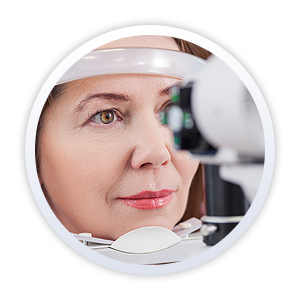The lens of the eye is normally clear but as we age, because the lens continues to grow, it thickens and slowly becomes opaque forming a cataract. Your vision will then become cloudy. Cataracts usually develop over many years but can form rapidly.
Cataracts are a common cause of decreased vision, usually in senior citizens. Most cataracts are caused by the natural aging of the eye. Cataracts can form from the following as well:
- Family history
- Medical problems, such as diabetes
- Eye injuries
- Medications, such as prednisone
- Long-term, unprotected exposure to sunlight
- Previous eye surgery
How fast a cataract will develop varies by individual and may even be different between the two eyes of an individual. However, most age-related cataracts develop over a period of years. Cataracts that are not age-related may progress rapidly. It is not possible to predict how quickly cataracts will develop in any person.
Surgery is the only way for a cataract to be removed. If the cataract is not bothering you, surgery may not be needed. A change in your glasses prescription may be helpful. Medications, exercises, or dietary supplements have not been shown to prevent or cure cataracts.
Over 1.8 million people in the United States have cataract surgery each year. Of those surgeries, over 95% are performed with no complications. Cataract surgery is usually performed under local or topical anesthesia as an outpatient procedure. The cataract or cloudy lens is removed from the eye through a tiny incision. In the majority of cases, the lens is replaced with an intraocular lens implant and the focusing power of the eye is restored. The surgery is performed using a microscope, small instruments, and other modern technology. Improved vision is a result of over 95% of cataract surgeries. It is important, however, to understand that complications can occur during or after surgery. If you are concerned or have a problem, you should contact your surgeon as soon as possible.
What to expect on the Day of Cataract Surgery
Cataract surgery is almost always performed in an outpatient surgical center. You should plan to arrive at the surgery center about 2 hours prior to surgery. Upon arrival to the hospital, you will be given intravenous fluids and a sedative may be given to help you relax. A local anesthetic will be given which will eliminate pain during surgery. You will also be given drops to fully dilate the pupil. Most cataract surgery is performed under local or topical anesthesia. With local anesthesia, the entire eye and eye muscles are numbed to prevent discomfort. With topical anesthesia, just the front of the eye is numbed. Either type of anesthesia allows the procedure to be performed painlessly. Your surgeon will determine the type of anesthesia.
During the operation, it is important that you remain still, including your hands and feet. If you feel pain, need to cough or sneeze, or you need to use the bathroom, gently tell us, but otherwise no talking is permitted. The patient will usually be instructed to look toward the light of the operating microscope. Cataract surgery is usually completed in just 10 to 15 minutes. Following the surgery, you will be monitored in the recovery area for a brief time. Once you are stable you will be discharged to go home. You must have a responsible adult to provide you with transportation. You will be given detailed instructions about the care of your eye and follow-up appointments. You will need to be seen the following day in your surgeon’s office.
Choice of IOLs for Cataract Surgery
Traditionally, most intraocular lens (IOL) implants placed during cataract surgery are fixed focus monofocal IOLs and have allowed for good vision only at distance to intermediate and do not provide a “full range” of functional vision. In this case, patients are still required glasses for reading, computer work and other intermediate and near vision activities. Some patients may decide to have monovision, whereby the lens implant placed in the second eye will focus on near vision while the other eye is focused on distant to intermediate vision. With monovision, the brain ultimately adapts to looking through the eye necessary for the required distance or close vision and thus the need for glasses is eliminated or reduced.
Advanced technology now offers accommodative intraocular lenses that give patients a full range of quality vision at near, intermediate and distance, and greatly increases their independence from glasses or contact lenses after cataract surgery. Your surgeon will assess whether you are a candidate for this new technology and will discuss your options.
What to Expect After Cataract Surgery
You should expect several follow-up visits with your surgeon and/or co-managing optometrist. Your surgeon may suggest wearing a bandage for a day or more to protect your eye from injury and bright light. Included with this may be a shield to wear at night to provide added protection as you sleep. Your eye may feel slightly irritated at first, but you should not have severe pain. If your pain becomes severe, you should notify your surgeon immediately. Lid swelling, drooping, tenderness, and a scratchy sensation are common temporary symptoms. The white part of your eye may appear bloodshot or red for a period of time after surgery.
Vision should gradually improve but some patience will be required as some patients progress more slowly than others. You should notify us immediately if your vision gets worse or if you develop a shadow, floaters, and/or flashing lights. You may gently clean around your eye, including your eyelashes, with a moist cloth or cotton ball as needed. Never rub your eye or press on your eye, as this is the worst thing you can do!
Activities You May Begin Doing The Day After Surgery:
- Any activity that does not require good depth perception.
- Bend or stoop over
- Ride in a car or drive, if your vision is good enough.
- Go to church, walk, go up and down stairs, dine out, shop, watch TV, read or sew.
- You may take showers and shampoo your hair (Please do not get soap in your eye)
- You may return to work immediately if your job does not involve fine depth perception.
- Resume most activities, unless strenuous! If you have questions about certain activities, you should ask your doctor.







